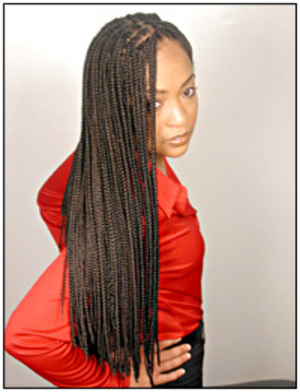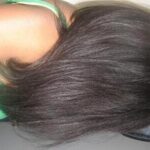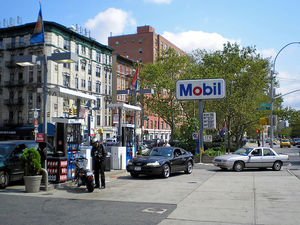Those wonderful braided styles from Africa are all the rage in the United States. Take a stroll down virtually every corner in America, and you’ll find a little shop which advertises African Hair Braiding. As a matter of fact, the trend has caught on very quickly, as braided styles have become more fashionable. Unlike other cosmetology services, hair braiding has been grossly overlooked in beauty school curriculums. Hair treatments such as relaxers, perms, coloring, and even haircuts are all services which do something to permanently alter the hair. For this reason, it seems that hair braiding salons are so plentiful. Braided techniques, however, do not generally affect the hair in a permanent manner. Instead, the tresses are manipulated with or without the addition of hair extensions.
Out of curiosity, I have adorned myself with a few of these intricate hairstyles. Many people are intrigued by the appearance, but have no idea how these mini-masterpieces are created. I can recall my first experience with hair braiding in New York City. I trekked all the way to Brooklyn to the cramped and stifling apartment of a middle-aged woman whose name I can no longer remember. I sat for hours in a semi-comfortable kitchen chair while the friendly lady parted and pulled my hair until it looked like one of the styles I’d seen in the magazines. It was not until years later that I realized the difference amongst all these complicated coifs.
BOX BRAIDS: The style which adorned my head in that sticky night in Brooklyn was ultimately described to me as “box braids.” The process of creating this style involves sectioning the hair in tiny “boxes” approximately 2 centimeters in length and width. Hair extensions (usually synthetic) are braided in with the natural hair, beginning at the root. The entire head is braided in this manner until all the hair has been combined with the extensions. After it’s complete, the braids can be cut in the desired length. Some patrons choose to wear their braided extensions extremely long. Some opt for a shorter bob.
Completely this type of braiding typically takes between 6 and 12 hours depending upon the client. In my case, I was out of that chair in a “quick” 8 hours. The time period it takes to complete, in and of itself, is enough to deter many ladies from opting for this particular style. Though it is a fairly maintenance-free ‘do, it’s important to make sure that the hair within the braids does not become too dry. To avoid this, spray the hair with specially-made braid treatments. These can be purchased in beauty supply stores, and even in supermarkets. The sprays work to keep the natural hair moist and conditioned-as sometimes the synthetic hair can dry the natural hair out.
ROWS AND ROWS… : I can recall the very first time I dared myself to get cornrows. Not really keen on spending virtually an entire day with someone’s fingers in my scalp, I decided to opt for a ‘do which could be done in about half the time. This time, the style would be a fresh new set of cornrows. Like the box braids, synthetic hair was added to my own, both to thicken and lengthen the rows. This style, however, offered something other than just reduced time in the styling chair: pain. I discovered the hard way that getting cornrows can really hurt. I had forgotten about how much it pained me when my Nana would put my delicate childhood tresses in this style (sans extensions, of course.) And I am quite certain that all patrons do not undergo the amount of pain that I endured, for the amount of tension created on the scalp varies from hand to hand. But in my tender-headed case, having fingers pulling my scalp tightly as the hair on my head was gathered up with the synthetic locks, was intolerable at times. I am aware that this sounds like some kind of foreign torture practice. I also know that the process of creating cornrows is an age-old practice. The truth of the matter is that it just depends on the patron and the stylist.
After all the rows were carefully braided down the length of my scalp, I dared myself to smile, lest my coiffed pate would pop open and reveal my thoughts. Surely, this is an exaggeration. But the point is that this particular braided style makes the head feel very tight at first, because all the braids are lying tightly against the scalp, instead of falling freely. However, it’s created in much less time than using individual tufts of hair. Cornrows are very neat looking. But this is a hairdo with a fairly short scalp-life. When hair grows quickly (as mine tends to do), the cornrows can end up looking quite ragged very soon. Furthermore, not everyone’s face is made for a ‘do which is done so close to the head. Newcomers to the style should also note that this very urban look must be translated into the corporate world very cautiously. Put multi-colored beads and streaks in this style, and you’ll be the pink elephant in the room that no one is supposed to notice.
TWIST AND SHOUT: When I was feeling adventurous, I decided that I should go for the kinky twist. No, I am not referring to a steamy storyline plot. I am referring to another interesting hairdo. From a distance, I’d had the opportunity to observe several women wearing this style. They looked simply majestic with these long dreadlocks of varying thickness and texture. Upon closer examination, I realized that these were not dreadlocks at all. They were kinky twists. They looked a lot simpler than individual box braids, which I considered a plus. But somehow they had more of an ethnic twist (no pun intended.)
Though there is some controversy regarding which twisted styles are which, there are actually quite a few variations on them. Senegalese twists tend to be a tad thicker than traditional “double-strand” twists. On my visit to the braiding salon, I had no idea which was which. I opted for the double-stranded kinky twist. Reddish brown synthetic hair was added to my own. Each section of hair is divided into two-strands and twisted all the way down to the ends, which are somehow left slightly undone. I asked my stylist how the braids would stay intact without coming unraveled. She explained that the tips would be dunked in very hot water in order to “set” the synthetic hair. I must announce that the twists were much smaller than I’d envisioned they’d be. I was also slightly disappointed with the state of my hairdo. I thought the twists would be longer, thicker, kinkier, and not so “shiny.” Instead of a gloriously kinky natural looking style, I was stuck with a frizzy, red, chin-length bunch of Twizzlers on my head. Over time, the twists seemed to adjust to my scalp, and I got used to them. They also started to look a bit more natural as well. Ultimately, they were quite attractive, once I got accustomed to them. The good part was that they only took about 4 to 5 hours to create. And, like the box braids, and cornrows, I learned that kinky twists required moisturizing on a fairly consistent basis. This, I discovered the hard way. For when it came time to remove these bad boys, it was much more difficult than I imagined: My impatience to remove them caused me to pluck out some of my own tresses along with the artificial ones.
MICROSCOPIC BEAUTY : The one braided hairstyle I have not indulged myself in is the ever-popular micro braided ‘do. I suppose after my “hair-raising” experience with the small twists sort of turned me off against other small braided hairstyles. This style is elaborately created very much like the box braids. The difference, however, is in the size. While the box styles are typically no smaller than pencil length, micro braids (often referred to as “micros”) are even smaller. Creation of this style can take as long as 10 to 14 hours because of the minute amounts of natural hair being pulled into the braid. I will admit that despite how lovely these hair designs looked, I was never willing to squander away that many hours for the sake of beauty. At any rate, these braids are extremely fashionable, as they are very versatile. Some micro braids are even left loose toward the end so as to make styling more adaptable. Unlike box braids, the size of these beauties is closer to individual strands of hair, which makes them more easily styled after completion.
TREE BRAIDS: I have finally found a happy medium between cornrows and micros. Tree braids are wonderful for a couple of reasons: 1) they typically require no more than three hours to complete. And, 2) they’re even more versatile than micros because much of the artificial hair remains loose, much like a hair weave. Like other braided styles, a benefit to having tree braids is that the natural hair underneath is protected from chemical treatments, and over manipulation. Tree braids are often called “Invisible Braids” because the actual braid is not readily visible to the eye.
For this style, the natural hair is actually corn rowed to the scalp, while the artificial hair is braided into each row, and left to hang loose. I have found this style to be infinitely less painful than ordinary cornrows, because each row is so small. Furthermore, as the natural hair grows out, it remains semi-hidden beneath the artificial tresses. This is a lifesaver for those “between salon” times. So, wearing them for longer than a month is no problem. Tree braids have become very chic amongst working women because they require very little maintenance outside of moisturizing. Depending upon the kind of extensions one chooses, even swimming or washing the hair is extremely easy. Some synthetic hair brands retain their natural bouncy curl after having been washed and dried. In addition the versatility of the style makes these braids unique to the woman wearing them. I must say, that of all the braided hairdos I’ve experimented with, this one is my favorite of all.
KEEP IN MIND…
Whether you’re attempting to grow your natural hair out (free of chemicals), or if you’re just tempted to try something different, there are few things that you should know. First of all, know that your own hair still needs a bit of maintenance, even when braided. It’s important to understand that synthetic styles and just day-to-day living will dry out most African American hair. There are dozens of braid hair treatments and shampoos which are specially made to maintain the style, while adding moisture to the scalp and natural hair.
Second, if your stylist is pulling your hair too tightly while braiding, say something immediately. Do not assume that just because she (or he) knows what she’s doing that she knows what’s best for your hair. Everyone has a different hair texture. And pulling hair too tightly (around the edges, especially) will cause the hair to fall out. This condition is called traction alopecia. Your scalp will feel different after it is braided. But you should not be in extreme pain once the style is complete. Moreover, the following day, your scalp should be much “looser” than it was at first. If not, take immediate action to loosen the braids, or have them loosened.
Wearing braided styles is wonderful. It’s a great way to give your hair a break during harsh summer (or winter) months. And it is a terrific way to encourage hair growth. But with any style, you want to make sure that you’re not doing anything to permanently damage the wonderful tresses already on your head.



